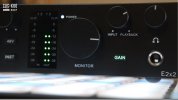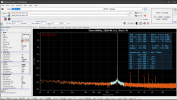- Joined
- Aug 13, 2022
- Messages
- 97
- Likes
- 878
This is not a formal review, just because I recently completed its measurements and saw that many people in the forum were curious. Since I have it, it's not a bad idea to share it. I, like everyone else, am looking forward to Amir's official review of it!



Its input and output parameters are not as 'impressive' considering there are already many products in this field that have reached their limits on the ASR forum. However, as a sound card designed for functional creativity, and with an estimated price of around $130, it is quite good.
LINE OUT

LINE IN

300Ω load with GAIN active:
106mW (THD+N<1%)
38mW(best)

Headphone preamp output can down to 1Ω
32Ω load with GAIN active:
615mW (THD+N<1%)
350mW(best)

EIN:-130dBu A(150Ω)
It could be better if my multimeter were more accurate and if I could control the temperature properly



Its input and output parameters are not as 'impressive' considering there are already many products in this field that have reached their limits on the ASR forum. However, as a sound card designed for functional creativity, and with an estimated price of around $130, it is quite good.
LINE OUT
LINE IN
300Ω load with GAIN active:
106mW (THD+N<1%)
38mW(best)
Headphone preamp output can down to 1Ω
32Ω load with GAIN active:
615mW (THD+N<1%)
350mW(best)
EIN:-130dBu A(150Ω)
It could be better if my multimeter were more accurate and if I could control the temperature properly
Last edited:


 )
)